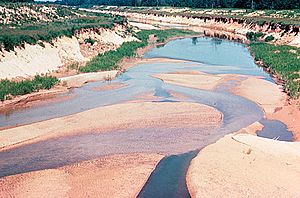Sedimentation facts for kids
Sedimentation is a natural process where solid particles, which are heavier than a liquid, slowly settle to the bottom. Imagine shaking a bottle of muddy water; if you let it sit, the mud will eventually sink. The settled solid bits are called sediments, and they form a layer at the bottom.
This process happens with many different things. It can involve large rocks moving in rivers or tiny dust and pollen particles floating in the air that eventually settle. Even very small things like cells, proteins, and other molecules can settle down in liquids.
Sedimentation is important in many areas. In geology, it describes how layers of sediment build up over time to form sedimentary rocks. In science and industry, it's used to separate different materials. For example, in biotech, it helps separate cells from the liquid they grow in.
Contents
What is Sedimentation?
Sedimentation is the process where solid particles fall out of a liquid or gas. This happens because of gravity, which pulls the heavier particles downwards. Think of sand in water or dust in the air. When the movement stops, these particles begin to sink.
The particles that settle are called sediments. They can be tiny, like silt or clay, or larger, like sand or pebbles. Over time, these sediments can build up and form layers.
How Does Sedimentation Work?
Sedimentation works because of the difference in weight between the particles and the liquid or gas they are in. Heavier particles are pulled down by gravity more strongly than the surrounding fluid. This causes them to sink.
The speed at which particles settle depends on a few things. Larger and heavier particles settle faster. The thickness of the liquid also matters; particles settle slower in thicker liquids like syrup compared to thin liquids like water.
Gravity's Role
Gravity is the main force behind sedimentation. It constantly pulls everything downwards, including the particles suspended in a fluid. When the force of gravity pulling a particle down is stronger than the forces holding it up (like the movement of the liquid), the particle will sink.
Particle Size and Weight
The size and weight of a particle greatly affect how fast it settles. Bigger and heavier particles sink more quickly. Imagine dropping a pebble and a feather into water; the pebble sinks much faster because it's heavier and more compact.
Liquid's Thickness
The thickness, or viscosity, of the liquid also plays a role. In a very thick liquid, particles will settle much slower because the liquid creates more resistance. Think of honey versus water. Particles will settle much slower in honey.
Where Do We See Sedimentation?
Sedimentation is a common process found all around us. It happens naturally in rivers, lakes, and oceans. It's also used in many human activities, from treating water to making medicines.
In Nature
- Rivers and Lakes: Rivers carry lots of sand, silt, and mud. When the river slows down, these sediments settle at the bottom, forming riverbeds and deltas. In lakes, fine particles slowly settle, making the water clearer over time.
- Oceans: Sediments from land are carried to the ocean by rivers. These particles settle on the seafloor, building up layers over millions of years. This process helps form sedimentary rocks.
- Dust in the Air: Dust and other tiny particles float in the air. When the air is still, these particles slowly settle onto surfaces, which is why things get dusty.
In Everyday Life
- Water Treatment: Sedimentation is a key step in cleaning drinking water. Water from rivers or lakes often contains tiny bits of dirt and other particles. In water treatment plants, water is put into large tanks where these particles are allowed to settle to the bottom. This helps make the water clean and safe to drink.
- Wastewater Treatment: Similar to drinking water, wastewater (used water from homes and industries) is also treated using sedimentation. Solid waste particles are removed by letting them settle, which helps clean the water before it's returned to the environment.
- Food Industry: Sedimentation can be used in the food industry. For example, in making fruit juices, pulp or other solid bits might settle to the bottom of the bottle over time.
- Mining: In mining, sedimentation is used to separate valuable minerals from unwanted rock particles.
Sedimentation in Science and Industry
Scientists and engineers use sedimentation for many important tasks. It's a simple yet powerful way to separate different materials.
Separating Mixtures
Sedimentation is a common way to separate mixtures of solids and liquids. If you have a mixture where solid particles are floating in a liquid, you can let them settle. Once settled, the clear liquid can be poured off, leaving the solids behind. This is called decantation.
Forming Rocks
In geology, sedimentation is crucial for forming sedimentary rocks. Over long periods, layers of settled sediments (like sand, mud, and dead organisms) get pressed together. The weight of the layers above squeezes out water and air. Minerals act like glue, cementing the particles together to form solid rock. Examples include sandstone, shale, and limestone.
In Biotechnology
In biotechnology, sedimentation is used to separate cells from the liquid they are grown in. For example, when scientists grow bacteria or yeast in a liquid, they often need to separate the cells for further study or use. They can use a machine called a centrifuge which spins the liquid very fast. This spinning creates a strong force that makes the cells settle much faster than they would under normal gravity.
See also
 In Spanish: Sedimentación para niños
In Spanish: Sedimentación para niños


